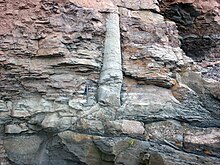| Part of a series on | ||||
| Creationism | ||||
|---|---|---|---|---|
 | ||||
| History | ||||
| Types | ||||
| Biblical cosmology | ||||
| Creation science | ||||
| Rejection of evolution by religious groups | ||||
| Religious views | ||||
|
||||


A polystrate fossil is a fossil of a single organism (such as a tree trunk) that extends through more than one geological stratum.[1] The word polystrate is not a standard geological term. This term is typically found in creationist publications.[1][2]
This term is typically applied to "fossil forests" of upright fossil tree trunks and stumps that have been found worldwide, i.e. in the Eastern United States, Eastern Canada, England, France, Germany, and Australia, typically associated with coal-bearing strata.[3] Within Carboniferous coal-bearing strata, it is also very common to find what are called Stigmaria (root stocks) within the same stratum. Stigmaria are completely absent in post-Carboniferous strata, which contain either coal, polystrate trees, or both.
- ^ a b MacRae, A., 1997, "Polystrate" Tree Fossils. TalkOrigins Archive.
- ^ Gastaldo, R.A. 1999. Debates on Autochthonous and Allochthonous Origin of Coal: Empirical Science versus the Diluvialists, In Manger, W.L., ed., The Evolution-Creation Controversy II: Perspectives on Science, Religion, and Geological Education, The Paleontological Society Papers, v. 5, p. 135-167.
- ^ DiMichele, W.A., and H.J. Falcon-Lang, 2011, Pennsylvanian 'fossil forests' in growth position (T0 assemblages): origin, taphonomic bias and palaeoecological insights. Journal of the Geological Society, 168(2):585-605.